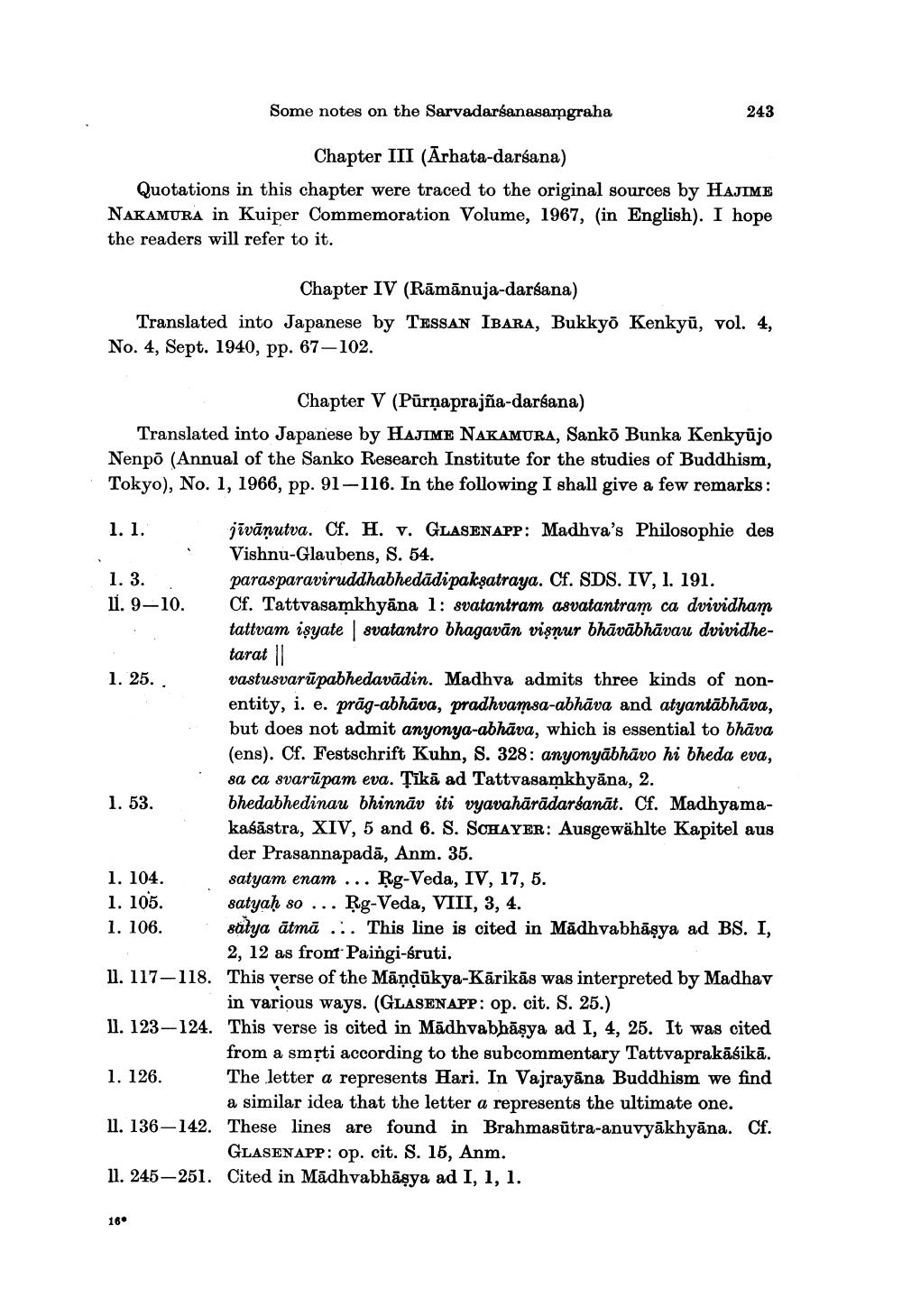Book Title: Some Notes On The Sarva Darsana Samgraha Author(s): Hajime Nakamura Publisher: Hajime Nakamura View full book textPage 3
________________ Some notes on the Sarvadarśanasamgraha 243 Chapter III (Arbata-darsana) Quotations in this chapter were traced to the original sources by HAJIME NAKAMURA in Kuiper Commemoration Volume, 1967, (in English). I hope the readers will refer to it. Chapter IV (Rāmānuja-darsana) Translated into Japanese by TESSAN IBARA, Bukkyo Kenkyū, vol. 4, No. 4, Sept. 1940, pp. 67–102. Chapter V (Pūrņaprajña-darsana) Translated into Japanese by HAJIME NAKAMURA, Sanko Bunka Kenkyūjo Nenpo (Annual of the Sanko Research Institute for the studies of Buddhism, Tokyo), No. 1, 1966, pp. 91–116. In the following I shall give a few remarks: 1. 25. 1. 1. jīvānutva. Cf. H. v. GLASENAPP: Madhva's Philosophie des Vishnu-Glaubens, S. 54. 1. 3. parasparaviruddhabhedādipakşatraya. Cf. SDS. IV, 1. 191. 11. 9-10. Cf. Tattvasamkhyāna 1: svatantram asvatantram ca dvividham tattvam isyate svatantro bhagavān vişnur bhāvābhāvau dvividhetarat | vastusvarūpabhedavādin. Madhva admits three kinds of nonentity, i. e. prāg-abhāva, pradhvamsa-abhāva and atyantābhāva, but does not admit anyonya-abhāva, which is essential to bhāva (ens). Cf. Festschrift Kuhn, S. 328: anyonyābhāvo hi bheda eva, sa ca svarūpam eva. Tikā ad Tattvasamkhyāna, 2. 1. 53. bhedabhedinau bhinnāv iti vyavahārādarsanāt. Cf. Madhyama kaśāstra, XIV, 5 and 6. S. SCHAYER: Ausgewählte Kapitel aus der Prasannapadā, Anm. 35. 1. 104. satyam enam ... Rg-Veda, IV, 17, 5. 1. 105. satyaḥ so ... Rg-Veda, VIII, 3, 4. 1. 106. satya ātmā ... This line is cited in Mădhvabhāşya ad BS. I, 2, 12 as front Paingi-sruti. 11. 117–118. This verse of the Māņdūkya-Kārikās was interpreted by Madhav in various ways. (GLASENAPP: op. cit. S. 25.) 11. 123–124. This verse is cited in Madhvabhāşya ad I, 4, 25. It was cited from a smrti according to the subcommentary Tattvaprakāśikā. 1. 126. The letter a represents Hari. In Vajrayāna Buddhism we find a similar idea that the letter a represents the ultimate one. 11. 136-142. These lines are found in Brahmasūtra-anuvyākhyāna. Cf. GLASENAPP: op. cit. S. 15, Anm. 11. 245—251. Cited in Mādhvabhāşya ad I, 1, 1. 16Page Navigation
1 2 3 4 5 6 7 8 9 10 11
